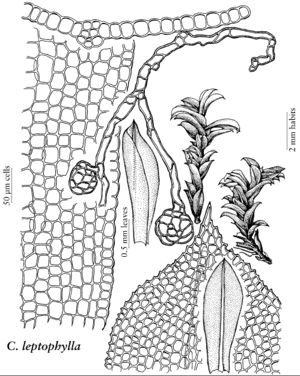Chenia
Phytologia 65: 424. 1989 ,.
| Taxon | Illustrator ⠉ | |
|---|---|---|
 | Chenia leptophylla | Patricia M. Eckel |
Plants forming a low turf, green distally, brownish proximally. Stems short-to-elongate, to 3 mm; hyalodermis absent, sclerodermis present, central strand weak to strong; axillary hairs small, of 3–4 cells, proximal cell firm-walled. Leaves appressed and contorted when dry, spreading when moist; ligulate to elliptic, adaxial surface occasionally grooved along costa, plane or broadly channeled across leaf. 1.5–2.5 mm; base rectangular or not differentiated in shape; margins distally plane, weakly recurved or plane basally, irregularly denticulate distally with sharp, mid cell projections ending in a simple papilla, marginal cells often smaller; apex rounded to broadly acute, occasionally sharply apiculate; costa weak, ending several (6–9) cells before the apex or percurrent, lamina inserted adaxially to laterally, adaxial cells shortrectangular, narrower than laminal cells, in 2 rows, abaxial cells shortrectangular; transverse-section rounded to elliptic, adaxial epidermis present, adaxial stereid band absent, guide cells 2 in 1 layers, hydroid strand present, small to large, abaxial stereid band very weak or occasionally absent, rounded in sectional shape, abaxial epidermis present; proximal cells differentiated across the leaf base except for one or more rows of marginal cells, rectangular; distal medial cells large, (15–) 20–25 (–30) µm wide, 1: 1, bulging-hexagonal, 1-stratose; papillae absent (distal marginal teeth may interpreted as sharp papillae), cell-walls thin, weakly trigonous, convex on both sides. Specialized asexual reproduction by brood bodies that sometimes present on rhizoids in soil. Sexual condition dioicous. [Seta ca. 1.2 cm. Capsule stegocarpous or cleistocarpous; theca ovate; annulus of 2–3 layers of strongly vesiculose cells, persistent; peristome teeth when present 16, filamentous, somewhat anastomosing, straight or weakly twisted counterclockwise. Calyptra cucullate. Spores ca. 10 µm.] KOH laminal color reaction red.
Distribution
North America, Mexico, South America, Europe, e Asia, Australia
Discussion
Species 3 (1 in the flora).
Chenia includes both cleistocarpous and peristomate taxa. The diagnostic characters are leaves ligulate to spathulate, sharply crenulate to irregularly dentate above with sharp mid-marginal wall projections, often sharply apiculate by a distinctive thick-walled cell or cells, distal laminal cells large, weakly trigonous, epapillose, and red in KOH solution.